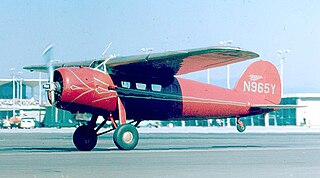
The Lockheed Vega is an American five- to seven-seat high-wing monoplane airliner built by the Lockheed Corporation starting in 1927. It became famous for its use by a number of record-breaking pilots who were attracted to its high speed and long range. Amelia Earhart became the first woman to fly solo across the Atlantic Ocean in one, and Wiley Post used his to prove the existence of the jet stream after flying around the world twice.

The Sikorsky S-42 was a commercial flying boat designed and built by Sikorsky Aircraft to meet requirements for a long-range flying boat laid out by Pan American World Airways in 1931. The innovative design included wing flaps, variable-pitch propellers, and a tail-carrying full-length hull. The prototype first flew on 29 March 1934, and, in the period of development and test flying that followed, quickly established ten world records for payload-to-height. The "Flying Clipper" and the "Pan Am Clipper" were other names for the S-42.
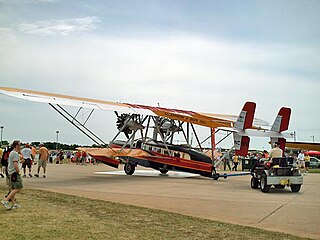
The Sikorsky S-38 was an American twin-engined ten-seat sesquiplane amphibious aircraft. It was Sikorsky's first widely produced amphibious flying boat, serving successfully for Pan American Airways and the United States military.

The Sikorsky S-29-A was a twin-engine sesquiplane airliner, first flown in 1924. It was the first aircraft that aviation pioneer Igor Sikorsky designed and built after coming to the United States, hence the special "-A" suffix signifying "America". The aircraft made many successful long-range flights, most of which Sikorsky piloted himself. The S-29-A claims a number of "firsts" in aviation, including the first twin-engine aircraft capable of maintaining altitude on one engine, the first aircraft to broadcast a radio musical program in-flight, in 1925 and in 1926 the first aircraft to display a motion picture in flight. The S-29-A was also one of the first aircraft to make use of an airstair door, located on the starboard side of the fuselage.

The Sikorsky S-40 was an American amphibious flying boat built by Sikorsky in the early 1930s for Pan American Airways. During WW2 they were used by the United States Navy for training.

The Keystone–Loening K-84 Commuter was a single-engine closed-cabin 4-place biplane amphibious flying boat built by Keystone–Loening. It was powered by a 300 hp Wright Whirlwind engine mounted between the wings with the propeller just ahead of the windscreen. It was first produced in 1929.
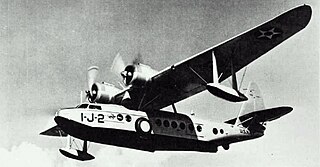
The Sikorsky S-43 is a 1930s American twin-engine amphibious flying boat monoplane produced by Sikorsky Aircraft.
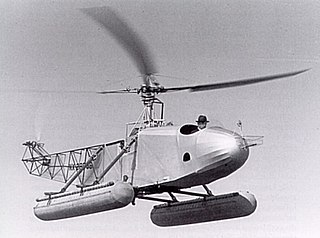
The Vought-Sikorsky VS-300 is an American single-engine helicopter designed by Igor Sikorsky. It had a single three-blade rotor originally powered by a 75 horsepower (56 kW) engine. The first "free" flight of the VS-300 was on 13 May 1940. The VS-300 was the first successful single lifting rotor helicopter in the United States and the first successful helicopter to use a single vertical-plane tail rotor configuration for antitorque. With floats attached, it became the first practical amphibious helicopter.

The Sikorsky VS-44 was a large four-engined flying boat built in the United States in the early 1940s by Sikorsky Aircraft. Based on the XPBS-1 patrol bomber, the VS-44 was designed primarily for the transatlantic passenger market, with a capacity of 40+ passengers. Three units were produced: Excalibur, Excambian, and Exeter, plus two XPBS-1 prototypes.

The Pitcairn Mailwing family is a series of American mail carrier and three-seat sport utility biplane aircraft produced from 1927 to 1931.

The Fokker F-11 was a luxury flying boat produced as an 'air yacht' in the United States in the late 1920s. Technically the aircraft was the Fokker Aircraft Corporation of America's Model 9. It was sold in North America as the Fokker F-11 and was offered in Europe as the Fokker B.IV. By the time the first six aircraft had been constructed, it was already evident that the design was not going to sell well. A few were sold, two to notable multi-millionaires; Harold Vanderbilt and Garfield Wood each purchasing one. One was bought by Air Ferries in San Francisco. The F-11A cost $40,000 but the price was slashed to $32,500 as the depression set in during 1930. The F-11 was a commercial failure.

The Ryan S-C (Sports-Coupe) was an American three-seat cabin monoplane designed and built by the Ryan Aeronautical Company. At least one was impressed into service with the United States Army Air Forces as the L-10.

The Spencer Amphibian Air Car is an American light amphibious aircraft. The name was first used in 1940 for a prototype air vehicle that developed into the Republic Seabee. The name was later used by its designer Percival Spencer for a series of homebuilt amphibious aircraft roughly based on the Seabee design.

The Fairchild 100 Pilgrim is an American single-engined high-wing monoplane transport, and was one of a series of single-engine utility transports built by Fairchild Aircraft.
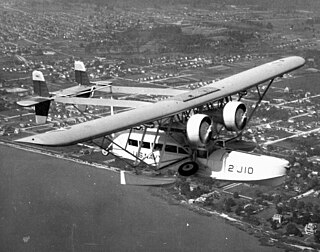
The Sikorsky S-41 was an amphibious flying boat airliner produced in the United States in the early 1930s. Essentially a scaled-up monoplane version of the Sikorsky S-38 biplane flying boat, Pan Am operated the type on routes in the Caribbean, South America, and between Boston and Halifax.

The Wright-Bellanca WB-1 was designed by Giuseppe Mario Bellanca for the Wright Aeronautical corporation for use in record-breaking flights.

The Spartan C2 is a light aircraft produced in the United States in the early 1930s as a low-cost sport machine that would sell during the Great Depression.
The Hall Air Yacht was a 2-seat, tandem, sesquiplane, flying boat, designed and built in the United States in 1923. The Air Yacht was Charles Ward Hall's first attempt at building an aircraft with his company Charles Ward Hall Inc. of Mamaroneck NY. Hall, and his later company Hall Aluminum Aircraft Corp., which would develop manufacturing processes for riveted aluminum alloy aircraft structures in the US.
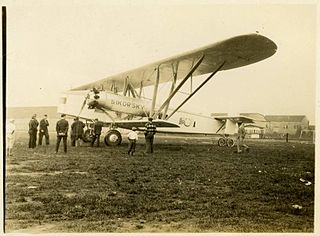
The Sikorsky S-37 was an American twin-engine aircraft built by the Sikorsky Manufacturing Corporation. Both examples of the series were completed in 1927. The S-37 was specifically designed to compete for the Orteig Prize and would be the last land based fixed-wing aircraft Sikorsky would produce.

USS Siren (PY-13), briefly CMc-1, was built by Pusey and Jones, Wilmington, Delaware and launched 15 November 1929 as the yacht Lotosland. The yacht was acquired by the United States Navy in October 1940 and placed in commission as a Patrol Yacht from 1940 to 1946.





















